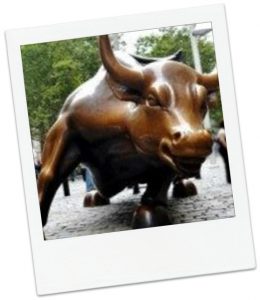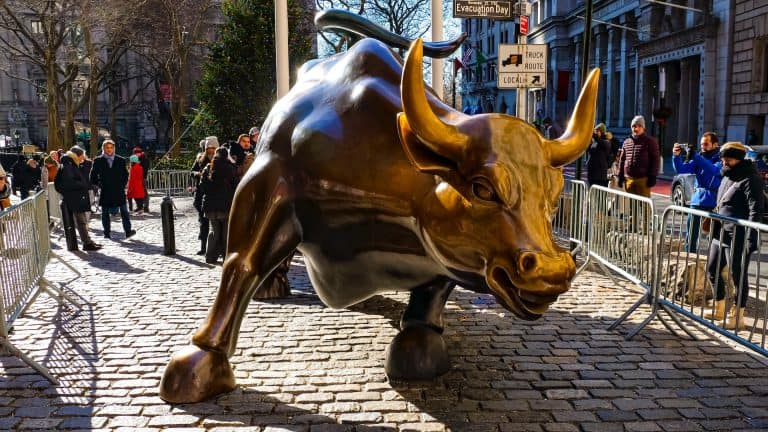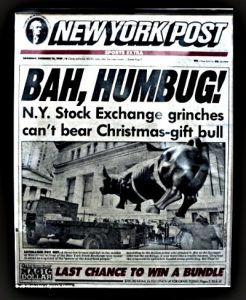You may have seen this bronze bull in pictures, postcards, or even in movies...but how much do you know about him?
We know this bull very well because it is the starting point of our walking tour of Lower Manhattan - and because, frankly, we love him!
Let us tell you about the iconic Charging Bull, the popular bronze statue along with a brief history.
And as local tour guides, we can tell you that regardless of whether you think it's a must-see or an overrated attraction, everyone gets a photo.
And, below is a video clip of Renee, a tour guide with us, Free Tours by Foot, giving you the lowdown on the bull.
- A Brief History
- How to Get Here
- Fearless Girl Statue
- Live Webcam
- Tours of Wall Street
- Free Tours by Foot
- Things to See in Lower Manhattan

HISTORY OF THE CHARGING BULL
It has many names: the Wall Street Bull, the Raging Bull, the New York Bull, the Financial District Bull, the Bowling Green Bull, and the New York Stock Exchange Bull.
All are referring to the same statue, the Charging Bull in New York's Financial District of Lower Manhattan.
The massive 7,000 lb. (3200 kg) bronze sculpture of a bull appeared on December 15, 1989, in front of the 60-foot Christmas tree on Broad Street in front of the New York Stock Exchange.
Who made this bull and how did it get there without anyone knowing?
MEANING AND SYMBOLISM
The Bull was created by Italian sculptor Arturo Di Modica. He was born in the small city of Vittoria, Sicily, on January 26, 1941.
After developing a following in Italy, he made his next move to America and settled in New York City in 1973.
He opened a studio on Grand Street in SoHo. In 1978 he moved to Crosby Street in Nolita.
After the stock market crash in 1986, Di Modica wanted to offer Americans something inspirational in return for them accepting him as a fellow countryman and supporting his art.
Thus, without being commissioned, Di Modica alone conceived and paid for the materials of the Charging Bull sculpture to symbolize the determination and spirit of the American people.

This was especially true for New Yorkers who, after the Wall Street crash, had to rally to pick up the pieces of a broken economy.
Di Modica chose the bull as a symbol of the “power of the American people,” he said.
Standing 11 feet high (3.4m) and 18 feet long (5.5m), the Bull’s right foot lurches forward, toward Wall Street, suggesting he is on the move financially.
His head is down and his nostrils flare as he charges into the commercial area.
But how did Di Modica get this huge bronze beast from his SoHo studio without the police catching on?
Di Modica wisely timed the security routes to the NYSE building and figured out he had 4 1/2 minutes to get away after he dropped off the bull and made a quick escape.
But his plan was stymied when he and the bull arrived in the early morning hours.
Di Modica discovered a Christmas Tree had been set up the previous day, blocking his escape route, so he dropped the Bull under the tree and left.

That day as stockbrokers arrived for work on Wall Street, they were greeted by this mighty bull and immediately fell in love with it.
But because of traffic and safety concerns at the tight intersection of Broad and Wall Streets, city officials decided to remove it the very same day.
The next day, the New York Post front page (famous for its scathing and funny headlines) read as follows: “Bah, Humbug! New York Stock Exchange grinches can’t bear Christmas gift bull.”
The City of New York accepted the gift and found a permanent home for the Charging Bull in Bowling Green Park, just a few blocks down Broadway from Wall Street.
It has remained there ever since.
For a more in-depth history and interesting anecdotes, see below.
WHERE IS THE CHARGING BULL STATUE?
Today, the Charging Bull is located on a pedestrian island at the end of Broadway in Lower Manhattan, in NYC's Financial District.
For directions from your starting point to the Bull, use this Google map for exact directions.
A side note. Although the statue is often referred to as the Wall Street Bull, it never was on Wall Street.
It was placed in front of the New York Stock Exchange on Broad St., just to the south of Wall Street.
By subway:
- 4 or 5 subway trains to Bowling Green station
- 1 train to Rector Street or South Ferry station (where you get the Staten Island Ferry)
- A, C, J, Z, 2, 3, 4,5 to Fulton Street Station. You will have to walk about 10 minutes south on Broadway from this Station.
- N, R to Whitehall Street or Cortlandt Street
TIP: If you are new to riding the subway, check out our posts on navigating the New York Subway and how to choose a MetroCard. We promise you will be glad you took a look at it!
By bus:
The m55 bus can be boarded in Midtown at 5th Avenue and 42nd Street and thereafter every two blocks along 5th Ave.
The bus takes you right to the Bull.
If you are planning on taking a hop-on-hop-off bus tour, most have a stop a block away from the Charging Bull at Battery Park.
Read our comparison post on New York City bus tours.
And if you are considering visiting at least 2 of NYC's most popular attractions (or even one of the hop-on-hop-off bus tours), then you might be able to save up to 50% on ticket prices with a tourist discount pass.
FEARLESS GIRL STATUE
UPDATE The Fearless Girl Statue has been removed from in front of the Charging Bull and has been installed in front of the New York Stock Exchange.
In 2017 on March 8th, which is International Women's Day, the Charging Bull was joined by a smaller, but just as fierce bronze statue called "Fearless Girl".
The statue (pictured on the right) was created by Kristen Visbal who was commissioned by State Street Global Advisors, a powerful worldwide money manager.
State Street is campaigning for corporate boards to include more women.
Fearless Girl symbolizes the fight for gender equality in the workforce, especially at the corporate level.
She stares confidently at the Bull and a plaque on the ground in front of her reads “Know the power of women in leadership."
Like the Charging Bull, Fearless Girl was installed in the middle of the night.
She was scheduled to be removed just a month later, but because of her popularity and the public outcry on social media for her to remain permanently, New York City's Mayor agreed for her to stay until February 2018.
ADDITIONAL HISTORY
As one of the most well-known statues in the world, it attracts people from around the globe, who line up to have their picture taken with the Charging Bull.
Many of the tourists steer for the head with their cameras, but almost as many trudge down the other end.
A myth has grown with the popularity of the statue: “It is supposed to be good luck financially to have your picture taken rubbing the two golden orbs that dangle between his back legs,”
I tell participants on the Lower Manhattan Tour of Free Tours by Foot. “That is why that part of his anatomy is just as shiny as the head and horns at the other end.”
Watch this video of our Lower Manhattan Tour.
The Downtown Alliance security guards tell of a woman who comes to the statue every December 15 to kiss his masculine anatomy.
Depending upon the temperature that day, the guards carry water to separate her lips from the cold metal.
People have been known to crawl all over the Bull — some becoming injured as they slid or fell off between his horns.
Since September 2011 and the Occupy Wall Street protesters began sleeping in Zuccotti Park further north on Broadway, barricades, and guards have been installed at the statue.
Because of the popularity of the Charging Bull, many companies have adopted the image — and have been sued by Di Modica. He spent two years creating the statue.
Due to its size, the bull was cast in sections, assembled, and polished at Di Modica’s SoHo studio.
The artist designed a series of 5 Charging Bull statues, which he says he hoped to install in cities around the world.
The city of Shanghai commissioned one, which was installed in May 2010; similar, but it is not the same as the Charging Bull in New York City.
The Shanghai Bull was installed in front of the Bund and is also known as the Bund Bull — and is younger than the New York City bull, reddish in color, and leans to the right, instead of the left.
It has a more menacing tail that spirals toward the sky, which Di Modica said, reflects the uplifting financial trend of the country.
A third bull was placed in Amsterdam at the home of Euronext in July 2012.
Because Europe was going through an economic crisis, Di Modica said this gift was made to encourage the European markets.
“Think positive! Together we will go up!” read a leaflet in front of the building containing the Amsterdam Exchange.
Related Content:










